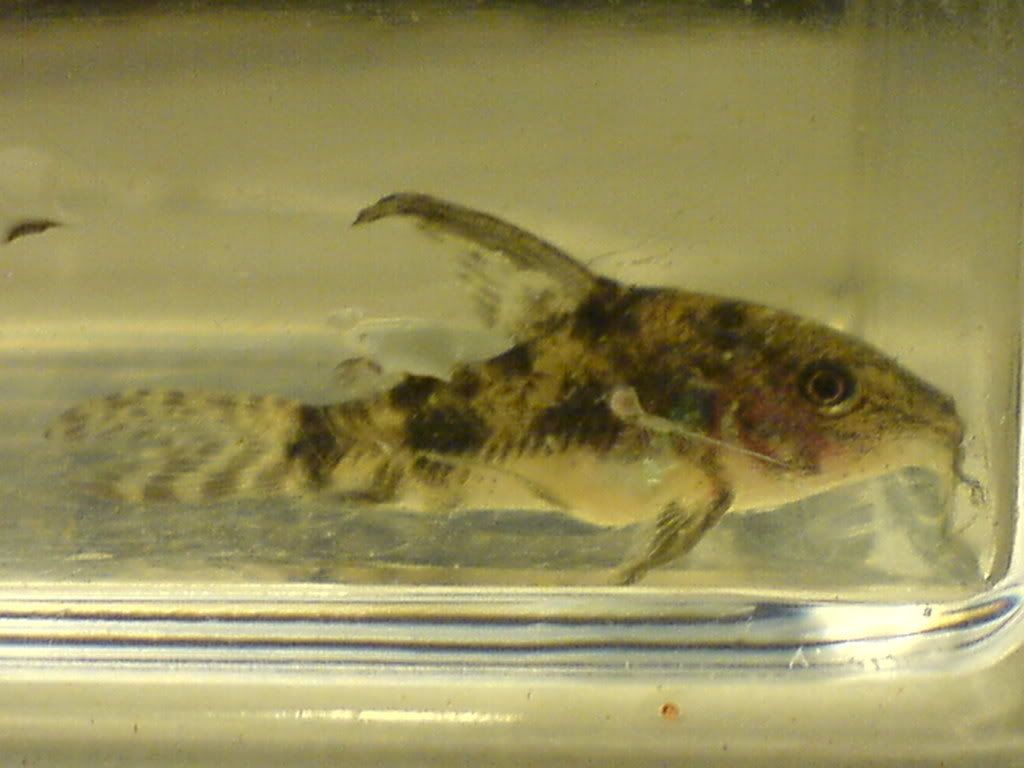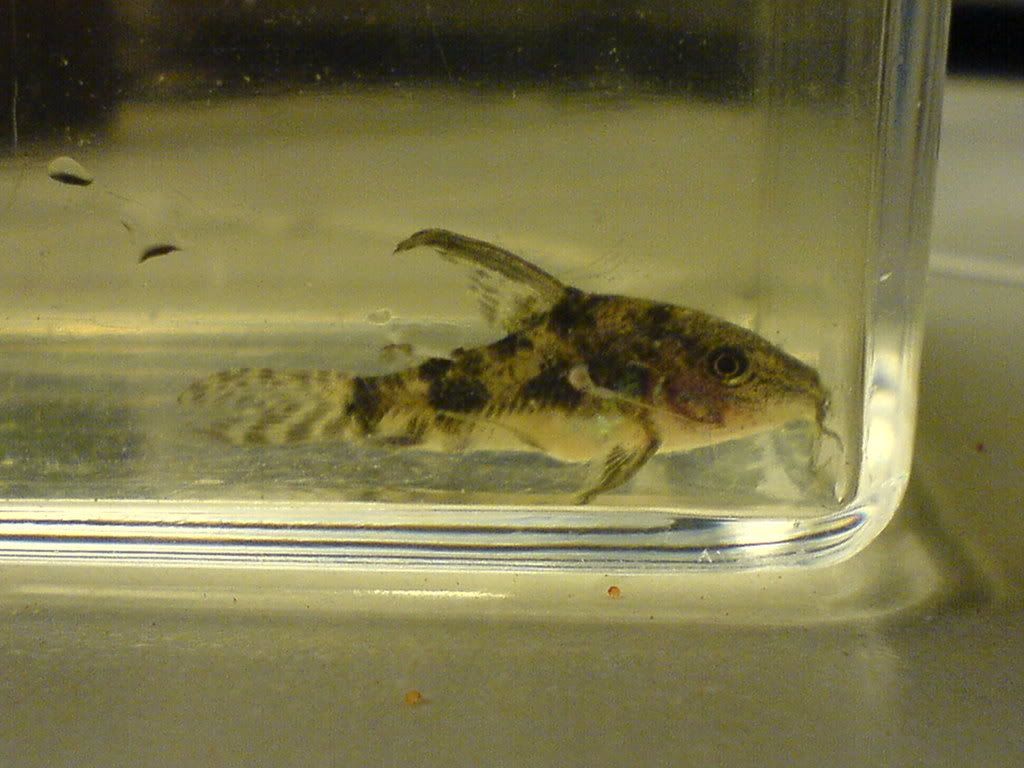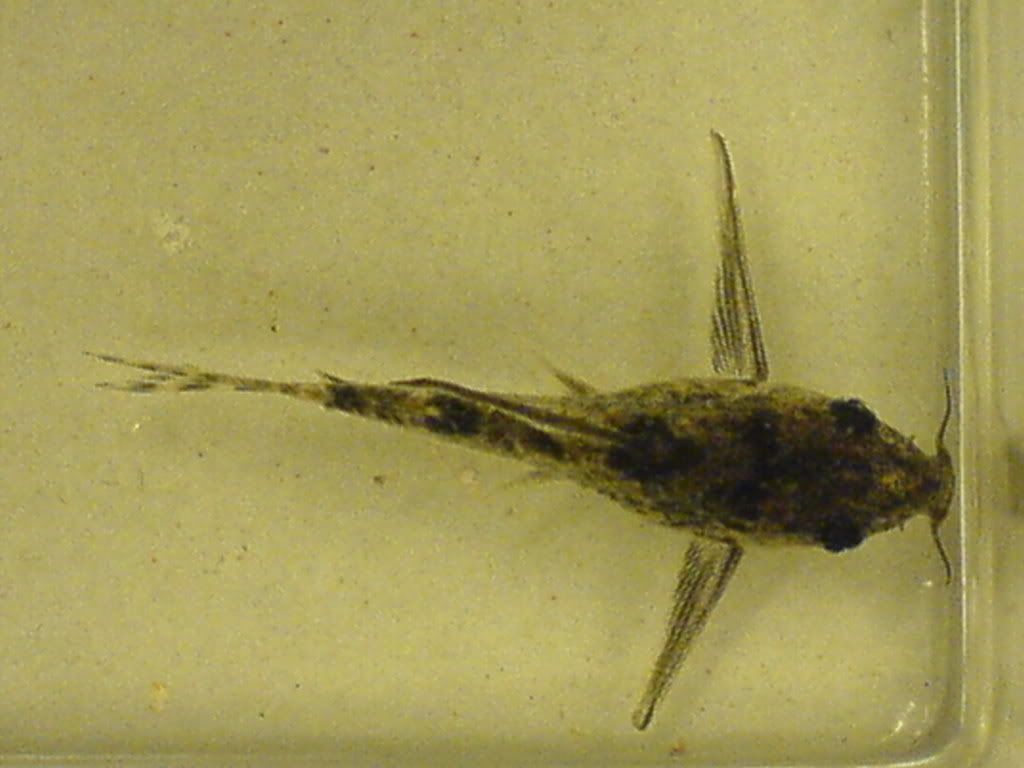Page 1 of 1
Strange looking paleatus.
Posted: 01 Sep 2007, 10:22
by Birger Amundsen
Posted: 01 Sep 2007, 11:20
by Marc van Arc
Hi Birger,
Do you happen to know anything about its origin?
If wildcaught it could be
, if not I think it's a longfinned variety of the normal C. paleatus.
Btw: what's the thing hanging from its right gill cover? Or is it just something that was floating in the tank?
Posted: 01 Sep 2007, 11:44
by Birger Amundsen
Hi Marc.
Dont know the origin of it. It was in a tank with normal paleatus. Got a few of the one one the pic, so only bought one.
Thought of longipinnis, but discussed with a friend of mine, and he tought it just was a underfeed paleatus.
The ting from the gills, is only some dirt in the tank:-)
Posted: 01 Sep 2007, 13:10
by Bas Pels
I never heard underfeeding results in apparentlyy too large fins for the tiny body
On the other hand, C longipinnis ony has a big dorsalfin (the males) and no extended pectoral fins
Let's find out whether the esperts have a clue
Posted: 01 Sep 2007, 13:15
by Birger Amundsen
Doesn`t look like a normal paleatus anyway? Maby i should by the rest

Posted: 01 Sep 2007, 13:38
by kim m
What I meant with the fish being underfed when I was discussin the fish with Birger over MSN was the big head on the thin body.
My theory was that it is a farm bred fish from Indonesia or something. Some of the Indonesian bred fish we see in Denmark are of somewhat poor quality anyway.
Posted: 01 Sep 2007, 14:41
by Birger Amundsen
Doesn`t look like a normal paleatus anyway? Maby i should by the rest

Posted: 01 Sep 2007, 15:45
by bronzefry
Just curious if this is a juvenile of an S.barbatus. The snout is quite long. C.longipinnis has a short snout.
Amanda
Posted: 01 Sep 2007, 16:02
by Birger Amundsen
Not barbatus. Got 10 of them, regularly spawning, so not barbatus.
Posted: 01 Sep 2007, 16:47
by Marc van Arc
Bas Pels wrote:On the other hand, C longipinnis ony has a big dorsalfin (the males) and no extended pectoral fins.
The pectorals are elongated to such an extent that they reach to the ventrals or even a little beyond them.
I'm certainly not an expert on Corys but this I can tell you first hand.
Posted: 01 Sep 2007, 17:16
by Birger Amundsen
Is it a paleatus or not? Would love to have longipinnis

Couldn`t be so lucky that it is?
Posted: 01 Sep 2007, 19:21
by Marc van Arc
This is one for Ian. He's an expert. Any other expert: share your view.
Posted: 01 Sep 2007, 20:03
by Birger Amundsen
Ian says longipinnis.
Posted: 01 Sep 2007, 22:47
by Marc van Arc
Birger Amundsen wrote:Ian says longipinnis.
Then so be it. Ian knows his Corys.
Posted: 02 Sep 2007, 10:04
by Coryman
To be honest here is a bit of a dilemma with paleatus when it comes down to farm bred fish. I believe that much of what we see in the trade being imported from fish farms in the far east are hybrids. When you look at groups of these fish they show characteristics from both species, making it virtually impossible to tell what species they actually are.
Ian
Posted: 05 Sep 2007, 16:02
by NEONCORY
Coryman wrote: When you look at groups of these fish they show characteristics from both species, making it virtually impossible to tell what species they actually are.
Ian
Hi Ian,
May I ask the charactristics of C.Longipinnis?(I post the thread asking for the difference between the C.Longipinnis and C.Paleatus but nobody answered

)
I understand that they are newly named and classified and all. But I don't even find much information(size, water parameter.,etc.) about C.Longipinnis except the report of classification.
So any info about C.Longipinnis would be appreciated.
Posted: 05 Sep 2007, 18:26
by apistomaster
I think it is just an underfed and somewhat misshapen common Corydoras paleatus. Other than it is a starved fish it is what the males look like after they are 18 to 24 months old.
I conclude this based on my local knowledge of the wholesale tropical fish business in Seattle where Neoncory lives. They sell only SE Asian bred C. paleatus and I can tell you from experience that the frequency of malformed fish is rather high. Many are foreshortened as compared to the wild fish as a standard for comparison. They don't have a reason to bring in a paleatus appearing wild Corydoras. Hard to explain but only one large operation in Seattle sells 90% of the area's fish.
They deliver weekly replacing only what has been sold which allows the shops to practice "just in time inventory." They pay dearly for the convenience but then again they can have variety with fewer tanks. It also results in every shop having nearly identical selections of fish.(Boring) Very few shops ship in from out of town wholesalers anymore in Seattle and the Pacific Northwest USA. Washington, Oregon, Alaska, Idaho and Montana are the primary markets for this operation.
I lived in Seattle about 30 years and my younger brother worked for the remaining and many previous now out of business wholesalers and retail shops before he passed away. Anyway through him I could follow much of what the trends were from an insider's perspective.
It affects me locally, as a breeder, because the LFS's are so dependent on the few same suppliers that they can't or won't buy fish in large lots as was once practiced. They just get replacements for what has sold or died in the past week to two weeks depending on how far away they are from Seattle.
Posted: 06 Sep 2007, 03:10
by NEONCORY
apistomaster wrote:I think it is just an underfed and somewhat misshapen common Corydoras paleatus. Other than it is a starved fish it is what the males look like after they are 18 to 24 months old.
I conclude this based on my local knowledge of the wholesale tropical fish business in Seattle where Neoncory lives. They sell only SE Asian bred C. paleatus and I can tell you from experience that the frequency of malformed fish is rather high. Many are foreshortened as compared to the wild fish as a standard for comparison. They don't have a reason to bring in a paleatus appearing wild Corydoras. Hard to explain but only one large operation in Seattle sells 90% of the area's fish.
They deliver weekly replacing only what has been sold which allows the shops to practice "just in time inventory." They pay dearly for the convenience but then again they can have variety with fewer tanks. It also results in every shop having nearly identical selections of fish.(Boring) Very few shops ship in from out of town wholesalers anymore in Seattle and the Pacific Northwest USA. Washington, Oregon, Alaska, Idaho and Montana are the primary markets for this operation.
I lived in Seattle about 30 years and my younger brother worked for the remaining and many previous now out of business wholesalers and retail shops before he passed away. Anyway through him I could follow much of what the trends were from an insider's perspective.
It affects me locally, as a breeder, because the LFS's are so dependent on the few same suppliers that they can't or won't buy fish in large lots as was once practiced. They just get replacements for what has sold or died in the past week to two weeks depending on how far away they are from Seattle.
Hi apistomaster,
Thanks for your input and educated guess from the location and knowledge of the fish business in my area. However, I did not obtained the group of "peppered cory" locally. They are shipped from East coast of Maryland bred by the breeder. Unfortunately, he sold the breeders and he does not know the definite ID of the fish. So it is most likely regular pepper but I read somewhere that C.Longipinnis is around the hobby for a while(meaning they could be kept and bred by the hobbyist for years) So if that is true, I don't think wild caught is the only mean to obtain this fish. So I thought I might got lucky although it may be a long shot.
And the picture of fish you commented is not my fish.
Anyway, here is the link for the auction I won and there is a picture with it. Although I am not expert of fish but I thought they really look like a C.Longipinnis. That is why I ask the way to distinguish the difference of 2 species.
http://www.aquabid.com/cgi-bin/auction/ ... 1186942606
P.S. Birger Amundsen, I am sorry about hijacking your thread. But I, too have the fish I am curious about their identity like you.

Posted: 06 Sep 2007, 20:12
by apistomaster
I would say the price is a good indication of of rarity in the hobby and $1.65 is in the Corydoras paleatus price range.
They do show a very nice healthy example of an adult male. I sold a breeding colony of what were three year old C. paleatus and the males all had the well developed dorsal,pectoral fins and pattern like the photo in the OP. If it's a different species then it's too close to call for me.
You have probably found by now how "controlled" the Seattle fish supply is. That probably has a lot to do with why we both find ourselves reaching out across the country for a variety of fish.





